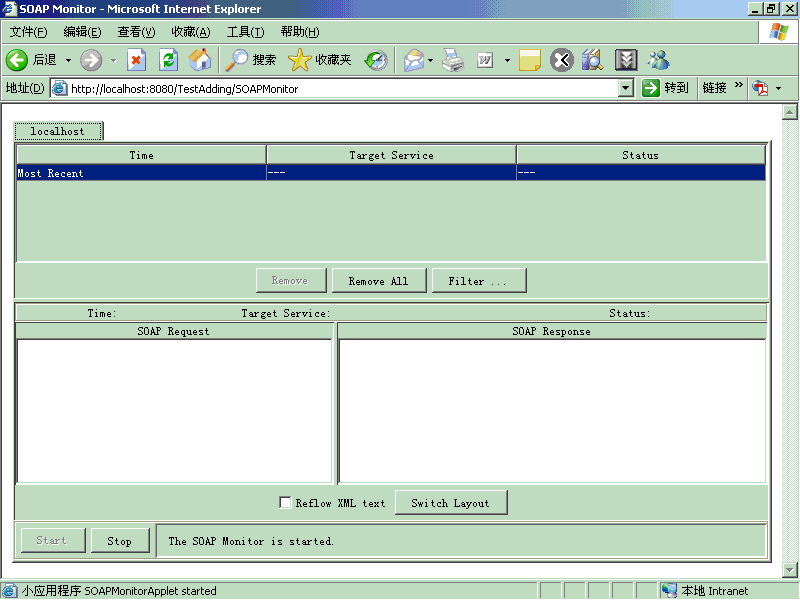Õ£¿tomcatÕ«╣ÕÖ¿õ©ïÞç¬ÕêøÕ¥ÅþÜäwebÕ║öþö¿õ©¡õ╣ƒÕÉ»Õè¿axisµ£ìÕèíÕQîµâ│ÞªüµÀ╗ÕèáSOAPMonitorþÜäµû╣µ│òµÿ»ÕQ?br /> 1ÒÇüþ╝ûÞ»?br /> ׫åaxisµá╣þø«Õ¢òõ©ïþÜäSOAPMonitorApplet.javaµûçõÜgÕñìÕêÂÕê░webÕ║öþö¿þÜäµá╣þø«Õ¢òõ©ï´╝î¥~û޻浡ñµûçõ╗ÂÕÉîµùÂÕ░åþöƒµêÉþÜäþ▒╗µûçõÜgÕñìÕêÂÕê░Õ║öþö¿µá╣þø«Õ¢òõ©ïþÜäWEB-INFþø«Õ¢òõ©ïÒÇ?br /> 2ÒÇüõ┐«µö╣web.xmlµûçõÜg
õ┐«µö╣WEB-INFþø«Õ¢òõ©ïþÜäweb.xmlµûçõÜgÕQîµÀ╗Õèáõ©ñõ©¬Õàâþ┤?lt;servlet>ÕÆ?lt;servlet-mapping>ÕQîÕàÀõ¢ôÕåàÕ«╣Õªéõ©ï´╝Ü(x¿¼)
<servlet>
<servlet-name>SOAPMonitorService</servlet-name>
<display-name>SOAPMonitorService</display-name>
<servlet-class>
org.apache.axis.monitor.SOAPMonitorService
</servlet-class>
<init-param>
<param-name>SOAPMonitorPort</param-name>
<param-value>5005</param-value>
</init-param>
<load-on-startup>100</load-on-startup>
</servlet>
<servlet-mapping>
<servlet-name>SOAPMonitorService</servlet-name>
<url-pattern>/SOAPMonitor</url-pattern>
</servlet-mapping>
3ÒÇüõ┐«µö╣server-config.wsddµûçõÜg
Úàìþ¢«µûçõÜgõ©¡µÀ╗ÕèásoapmonitorþÜäÚàì¥|«õ┐íµü»ÕªéÕQ?br /> <handler name="soapmonitor" type="java:org.apache.axis.handlers.SOAPMonitorHandler">
<service name="SOAPMonitorService" provider="java:RPC">
<parameter name="allowedMethods" value="publishMessage"/>
<parameter name="scope" value="Application"/>
<parameter name="className" value="org.apache.axis.monitor.SOAPMonitorService"/>
</service>
Õ»╣õ║ÄÚ£ÇÞªüÞó½soapmonitorþøæµÄºþÜäwebµ£ìÕèíÕQîÕ£¿ÕൣìÕèíÞ«¥¥|«õ©¡µÀıdèáõ┐íµü»Õªéõ©ï
<service name="TestAdding" provider="java:RPC">
<parameter name="allowedMethods" value="getAdd"/>
<parameter name="className" value="test.TestAdding"/>
<requestFlow>
<handler type="soapmonitor"/>
</requestFlow>
<responseFlow>
<handler type="soapmonitor"/>
</responseFlow>
</service>
4ÒÇüÞ┐ÉÞíîµÁïÞ»?br /> http://localhost:8080/TestAdding/SOAPMonitor

ÕæÁÕæÁÕQîÕÑ¢õ©ìÕ«╣µÿôµèÿÞàæÍÑ¢õ║å´╝îþ£ïµØÑÕăµØÑþÜäµâ│µ│òÞ┐ÿµÿ»Õ»╣þÜä´╝îÕŬõ©ìÿqçÕ£¿Úàìþ¢«µûçõÜgµùÂÕç║õ║åÚù«ÚóÿÒÇ?/font>
]]>
Destination port:80
Soap Toolkitµÿ»Õ«óµê´L(f¿Ñng)½»ÕÆîµ£ìÕèíÕÖ¿õ©¡þÜäõ©ÇÕ║ºµíÑÕQîlocal portµÿ»Soap ToolkitþÜäþøæÕɼþ½»ÕÅú´╝êµëÇõ╗?0þ½»ÕÅúõ©ÇÞê¼õ©ìÞâ¢õï╔þö¿´╝îÚÖñÚØ×þëÊÄ(gu¿®)«èÞ«æÍ«ÜÕQë´╝îÕçíµÿ»¥lÅÞ┐çlocal portþÜäÞ»Àµ▒éÚâ¢õ╝?x¿¼)Þó½µê¬õ©ïµØÑ´╝îþäÂÕÉÄþö▒Soap ToolkitÞ¢¼ÕÅæÕê░Destination hostÕQÜDestination portÕÄàRÇ?br /> µëÇõ╗Ñ´╝îW(xu¿ª)eb Services ClientÞªüÕ░åþ½»ÕÅúµîçÕ«ÜÕê░Trace UtilityþÜälocal port(õ╗└LäÅÞ«æÍ«Üõ©Çõ©¬þ½»ÕÅ?ÕQîTrace UtilityþÜäDestination portµîçÕ«ÜÕê░WebServiceþÜäþ½»ÕÅúÒÇéÞ┐Öµá°P╝î׫▒ÕÅ»õ╗ѵê¬ÞÄÀSoapµÂêµü»õ║åÒÇ?
]]>
õ©ÌZ║åÞ«?/span>SOAþÜäÕ║öþö¿Þâ¢Õñƒµø┤ÕèáþÜäµêÉþåƒÕQîõ©Çõ║øµáçÕçåÕîû¥läþ╗ç(õ©╗Þªüµ£?/span>W
þÉåÞ«║¢ï?br />
WS-Addressing Úù«ÚóÿþÜäÕ╝òÕç?br />
WS-Addressing EndpointReference
WS-Addressing Message Addressing Properties
Õ«×ÞÀÁ¢ï?/strong>
Applied WSE 3.0 to Web Service Project
Use Web Service Thought Message --- SoapClient
Úë┤õ║ÄSOAþÜ䵪éÕ┐ÁÕãêµ▓íµ£ëõ©║ÕñºÕ«ÂµëÇ‗q┐µ│øþÉåÞºúÕQîÕ£¿ÚÇéÕ¢ôþÜäµùÂÕÇÖµ£ëÕ┐àÞªüÕåÖõ©Çõ©?span style="color: #333399;">SOAõ╣▒Õ╝╣ÒÇ?/span>
õ©ìÞ┐çÕàêÞ»Àõ¢áÞ«░õ¢Åõ╗Ñõ©ïÕçáÕÅÑÞ»ØÕQ?br />
SOA is an integration solution.
SOA is message oriented first.
The Key character of SOA is loosely coupled.
SOA is enriched by creating composite apps.
þø©Õà│ÞÁäµ║ÉÕQ?br />
Web ServicesþÜäÞ«¥Þ«íõ©Äµ¿íÕ╝Å
Web Services Security¥pıdêù
ÕÅéÞÇâÞÁäµûÖ´╝Ü(x¿¼)WS-Addressing Specification
]]>
WSDLµÿ»õ©Çõ©¬þö¿õ║Äþ▓¥╝﫵ÅÅÿq░Webµ£ìÕèíþÜäµûçµíú´╝îW(xu¿ª)SDLµûçµíúµÿ»õ©Çõ©¬ÚüÁÕ¥¬WSDL XMLµ¿íÕ╝ÅþÜäXMLµûçµíúÒÇéWSDL µûçµíú׫åWebµ£ìÕèíÕ«Üõ╣ëõ©║µ£ìÕèíÞ«┐Úù«þé╣µêûþ½»ÕÅúþÜäÚøåÕÉêÒÇéÕ£¿ WSDL õ©¡´╝îþöÎâ║ĵ£ìÕèíÞ«ëKù«þé╣ÕÆîµÂêµü»þÜäµè¢Þ▒íÕ«Üõ╣ëÕÀ▓õ╗ÄÕàÀõ¢ôþÜäµ£ìÕèíÚâ¿þÍvµêûµò░µì«µá╝Õ╝Åþ╗æÕ«Üõ©¡Õêåþª╗Õç║µØÑÕQîÕøᵡñÕÅ»õ╗ÑÕ»╣µè¢Þ▒íÕ«Üõ╣ëÿqøÞíîÕåìµ¼íõ¢┐þö¿ÕQܵÂêµü»´╝îµîçÕ»╣õ║ñµìóµò░µì«þÜäµè¢Þ▒íµÅÅÿqÄ═╝øÞÇîþ½» ÕÅúþ▒╗Õ×ï´╝îµîçµôìõ¢£þÜäµè¢Þ▒íÚøåÕÉêÒÇéþö¿õ║Äþë╣Õ«Üþ½»ÕÅúþ▒╗Õ×ïþÜäÕàÀõ¢ôÕìÅÞ««ÕÆîµò░µì«µá╝Õ╝ÅÞºäÞîâµ×äµêÉõ║åÕÅ»õ╗ÑÕåìµ¼íõ¢┐þö¿þÜäþ╗æÕ«ÜÒÇéÕ░åWebÞ«ëKù«Õ£░ÕØÇõ©ÄÕÅ»Õåìµ¼íõ¢┐þö¿þÜäþ╗æÕ«Üþø©ÕàîÖüöÕQîÕÅ»õ╗ÑÕ«Üõ╣ëõ©Ç õ©¬þ½»ÕÅú´╝îÞÇîþ½»ÕÅúþÜäÚøåÕÉêÕêÖÕ«Üõ╣ëõÏô(f¿┤)µ£ìÕèíÒÇ?/p>
õ©Çõ©¬WSDLµûçµíúÚÇÜÕ©©ÕîàÕɽ7õ©¬ÚçìÞªüþÜäÕàâþ┤áÕQîÕì│typesÒÇüimportÒÇümessageÒÇüportTypeÒÇüoperationÒÇübindingÒÇ? serviceÕàâþ┤áÒÇéÞ┐Öõ║øÕàâþ┤áÕÁîÕÑùÕ£¿definitionsÕàâþ┤áõ©¡´╝îdefinitionsµÿ»WSDLµûçµíúþÜäµá╣Õàâþ┤áÒÇéµûçþ½áþÜäõ©ïõ©ÇÚâ¿Õêå׫åõ╝Ü(x¿¼)Þ»ªþ╗åõ╗ïþ╗ìWSDL þÜäÕƒ║µ£¼þ╗ôµ×äÒÇ?/p>
õ║î´╝Ü(x¿¼)WSDLþÜäÕƒ║µ£¼þ╗ôµ×?-µªéÞ┐░
Õªéþ¼¼õ©ÇÚâ¿Õêåµ£ÇÕÉĵÅÅÿq░þÜäÚéúµáÀÕQîõ©Çõ©¬Õƒ║µ£¼þÜäWSDLµûçµíúÕîàÕɽ7õ©¬ÚçìÞªüþÜäÕàâþ┤áÒÇéõ©ïÚØóÕ░åÕêåÕê½õ╗ïþ╗ìÿqÖÕçáõ©¬Õàâþ┤áõ╗ÑÕÅ?qi¿óng)õ╗ûõ╗¼þÜäõ¢£þö¿ÒÇ?/p>
WSDL µûçµíúÕ£¿Webµ£ìÕèíþÜäÕ«Üõ╣ëõ©¡õ¢┐þö¿õ©ïÕêùÕàâþ┤áÕQ?/p>
- Types - µò░µì«¥cıd×ïÕ«Üõ╣ëþÜäÕ«╣ÕÖ¿´╝îÕ«âõï╔þö¿µƒÉ┐Uìþ▒╗Õ×ïþ│╗¥l?õ©ÇÞê¼Õ£░õ¢┐þö¿XML Schemaõ©¡þÜä¥cıd×ï¥p╚Ø╗ƒ)ÒÇ?
- Message - ÚÇÜõ┐íµÂêµü»þÜäµò░µì«þ╗ôµ×äþÜäµè¢Þ▒í¥cıd×ïÕîûÕ«Üõ╣ëÒÇéõï╔þö¿TypesµëÇÕ«Üõ╣ëþÜäþ▒╗Õ×ïµØÑÕ«Üõ╣ëµò┤õ©¬µÂêµü»þÜäµò░µì«þ╗ôµ×äÒÇ?
- Operation - Õ»ÊÄ(gu¿®)£ìÕèíõ©¡µëǵö»µîüþÜäµôìõ¢£þÜäµè¢Þ▒íµÅÅÞ┐░ÕQîõ©ÇÞê¼Õìòõ©¬OperationµÅÅÞ┐░õ║åõ©Çõ©¬Þ«┐Úù«ÕàÑÕÅúþÜäÞ»õh▒é/ÕôìÕ║öµÂêµü»Õ»ÅVÇ?
- PortType - Õ»╣õ║ĵƒÉõ©¬Þ«ëKù«ÕàÑÕÅúþé╣þ▒╗Õ×ïµëǵö»µîüþÜäµôìõ¢£þÜäµè¢Þ▒íÚøåÕÉêÕQîÞ┐Öõ║øµôìõ¢£ÕÅ»õ╗Ñþö▒õ©Çõ©¬µêûÕñÜõ©¬µ£ìÕèíÞ«ëKù«þéÊÄ(gu¿®)Øѵö»µîüÒÇ?
- Binding - þë╣Õ«Üþ½»ÕÅú¥cıd×ïþÜäÕàÀõ¢ôÕìÅÞ««ÕÆîµò░µì«µá╝Õ╝ÅÞºäÞîâþÜäþ╗æÕ«ÜÒÇ?
- Port - Õ«Üõ╣ëõ©║ÕìÅÞ«?µò░µì«µá╝Õ╝Å¥læÕ«Üõ©ÄÕàÀõ¢ôWebÞ«ëKù«Õ£░ÕØÇ¥läÕÉêþÜäÕìòõ©¬µ£ìÕèíÞ«┐Úù«þé╣ÒÇ?
- Service- þø©Õà│µ£ìÕèíÞ«ëKù«þé╣þÜäÚøåÕÉêÒÇ?
ÕÅ»õ╗ÑÕÅéÞÇâõ©ïÕø¥µØÑþÉåÞºúõ©Çõ©ïWSDLþÜäµûçµíúþ╗ôµ×äÕø¥ÕQ?img alt="WSDLµûçµíúÕàâþ┤áþÜäþ╗ôµ×äÕø¥" src="http://p.blog.csdn.net/images/p_blog_csdn_net/juxtapose/wsdl-01.gif" />
WSDLþÜäxml schemaÕÅ»õ╗ÑÕÅéþàºÕªéõ©ï¥|æÕØÇÕQ?a target="_blank">http://schemas.xmlsoap.org/wsdl/
õ©ë´╝Ü(x¿¼)WSDLþÜäÕƒ║µ£¼þ╗ôµ×?-Þ»ªÞ┐░
µ£¼Þèé׫åÚÇÜÞ┐çõ©Çõ©¬õ¥ïÕ¡ÉÞ»ª¥låµÅÅÿq░WSDLµûçµíúµ»Åõ©¬Õàâþ┤áþÜäõ¢£þö¿ÒÇéõ©ïÚØóõ©Çõ©¬õ¥ïաɵÿ»õ©Çõ©¬þ«ÇÕìòþÜäWSDLµûçµíúþÜäÕåàÕ«╣´╝î޻ѵûçµíúþÜäõ║ºþöƒÕÅ»õ╗ÑÕÅéÞºüµêæþÜäÕŪÕñûõ©Ç¢ïçµûçþ½á´╝Ü(x¿¼)xfireÕ╝ÇÕÅæÕ«×õ¥?-HelloWorld¢ï?/a> ÒÇ?/p>
õ©Çõ©¬þ«ÇÕìòþÜäWeb ServiceþÜäWSDLµûçµíúÕQî޻ѵ£ìÕèíµö»µîüÕÉìõÏô(f¿┤)sayHelloþÜäÕö»õ©Çµôìõ¢£ÕQî޻ѵôìõ¢£ÚÇÜÞ┐çÕ£¿httpõ©èÞ┐ÉÞí?a target="_blank" >SOA
<wsdl:definitions
targetNamespace="http://com.liuxiang.xfireDemo/HelloService"
xmlns:tns="http://com.liuxiang.xfireDemo/HelloService"
xmlns:wsdlsoap="http://schemas.xmlsoap.org/wsdl/soap/"
xmlns:soap12="http://www.w3.org/2003/05/soap-envelope"
xmlns:xsd="http://www.w3.org/2001/XMLSchema"
xmlns:soapenc11="http://schemas.xmlsoap.org/soap/encoding/"
xmlns:soapenc12="http://www.w3.org/2003/05/soap-encoding"
xmlns:soap11="http://schemas.xmlsoap.org/soap/envelope/"
xmlns:wsdl="http://schemas.xmlsoap.org/wsdl/">
<wsdl:types>
<xsd:schema xmlns:xsd="http://www.w3.org/2001/XMLSchema"
attributeFormDefault="qualified" elementFormDefault="qualified"
targetNamespace="http://com.liuxiang.xfireDemo/HelloService">
<xsd:element name="sayHello">
<xsd:complexType>
<xsd:sequence>
<xsd:element maxOccurs="1" minOccurs="1"
name="name" nillable="true" type="xsd:string" />
</xsd:sequence>
</xsd:complexType>
</xsd:element>
<xsd:element name="sayHelloResponse">
<xsd:complexType>
<xsd:sequence>
<xsd:element maxOccurs="1" minOccurs="1"
name="out" nillable="true" type="xsd:string" />
</xsd:sequence>
</xsd:complexType>
</xsd:element>
</xsd:schema>
</wsdl:types>
<wsdl:message name="sayHelloResponse">
<wsdl:part name="parameters" element="tns:sayHelloResponse" />
</wsdl:message>
<wsdl:message name="sayHelloRequest">
<wsdl:part name="parameters" element="tns:sayHello" />
</wsdl:message>
<wsdl:portType name="HelloServicePortType">
<wsdl:operation name="sayHello">
<wsdl:input name="sayHelloRequest"
message="tns:sayHelloRequest" />
<wsdl:output name="sayHelloResponse"
message="tns:sayHelloResponse" />
</wsdl:operation>
</wsdl:portType>
<wsdl:binding name="HelloServiceHttpBinding"
type="tns:HelloServicePortType">
<wsdlsoap:binding style="document"
transport="http://schemas.xmlsoap.org/soap/http" />
<wsdl:operation name="sayHello">
<wsdlsoap:operation soapAction="" />
<wsdl:input name="sayHelloRequest">
<wsdlsoap:body use="literal" />
</wsdl:input>
<wsdl:output name="sayHelloResponse">
<wsdlsoap:body use="literal" />
</wsdl:output>
</wsdl:operation>
</wsdl:binding>
<wsdl:service name="HelloService">
<wsdl:port name="HelloServiceHttpPort"
binding="tns:HelloServiceHttpBinding">
<wsdlsoap:address
location="http://localhost:8080/xfire/services/HelloService" />
</wsdl:port>
</wsdl:service>
</wsdl:definitions>
♦ typesÕàâþ┤áõ¢┐þö¿XMLµ¿íÕ╝ÅÞ»¡Þ¿ÇÕú░µÿÄÕ£¿WSDLµûçµíúõ©¡þÜäÕàÂõ╗ûõ¢ìþ¢«õ¢┐þö¿þÜäÕñìµØéµò░µì«þ▒╗Õ×ïõ©ÄÕàâþ┤áÕQ?/p>
♦ importÕàâþ┤á¥cÍM╝╝õ║ÄXMLµ¿íÕ╝ŵûçµíúõ©¡þÜäimportÕàâþ┤áÕQîþö¿õ║Äõ╗ÄÕàÂõ╗ûWSDLµûçµíúõ©¡Õ»╝ÕàÑWSDLÕ«Üõ╣ëÕQ?/p>
♦ messageÕàâþ┤áõ¢┐þö¿Õ£¿WSDLµûçµíúþÜätypeÕàâþ┤áõ©¡Õ«Üõ╣ëµêûÕ£¿importÕàâþ┤áÕ╝òþö¿þÜäÕñûÚâ¿WSDLµûçµíúõ©¡Õ«Üõ╣ëþÜäXMLµ¿íÕ╝ÅþÜäÕåà¥|«þ▒╗Õ×ïÒÇüÕñìµØéþ▒╗Õ×ïµêûÕàâþ┤áµÅÅÞ┐░õ║åµÂêµü»þÜäµ£ëµòêÞ┤ƒÞØ▓ÕQ?/p>
♦ portTypeÕàâþ┤áÕÆîoperationÕàâþ┤áµÅÅÞ┐░õ║åWebµ£ìÕèíþÜäµÄÑÕÅúÕãêÕ«Üõ╣ëõ║åõ╗ûþÜäµû╣µ│òÒÇéportTypeÕàâþ┤áÕÆîoperationÕàâþ┤á¥cÍM╝╝õ║? javaµÄÑÕÅúÕÆîµÄÑÕÅúõ©¡Õ«Üõ╣ëþÜäµû╣µ│òÕú░µÿÄÒÇéoperationÕàâþ┤áõ¢┐þö¿õ©Çõ©¬µêûÞÇàÕñÜõ©¬message¥cıd×ïµØÑÕ«Üõ╣ëõ╗ûþÜäÞ¥ôÕàÑÕÆîÞ¥ôÕç║þÜäµ£ëµòêÞ┤ƒÞ¢¢´╝ø
♦ BindingÕàâþ┤á׫åportTypeÕàâþ┤áÕÆîoperationÕàâþ┤áÞÁïþ╗Öõ©Çõ©¬þë╣îDèþÜäÕìÅÞ««ÕÆîþ╝ûþáüµáÀÕ╝Å´╝ø
♦ serviceÕàâþ┤áÞ┤ƒÞ┤ú׫åInternetÕ£░ÕØÇÞÁïþ╗Öõ©Çõ©¬ÕàÀõ¢ôþÜä¥læÕ«ÜÕQ?/p>
1ÒÇüdefinitionsÕàâþ┤á
µëǵ£ëþÜäWSDLµûçµíúþÜäµá╣Õàâþ┤áÕØçµÿ»definitionsÕàâþ┤áÒÇéÞ»ÑÕàâþ┤á׫üÞúàõ║åµò┤õ©¬µûçµíú´╝îÕÉîµùÂÚÇÜÞ┐çÕàÂnameµÅÉõ¥øõ║åõ©Çõ©¬WSDLµûçµíúÒÇéÚÖñõ║åµÅÉõ¥øõ©Çõ©¬Õæ¢ÕÉìþ®║Úù┤ÕñûÕQîÞ»ÑÕàâþ┤áµ▓íµ£ëÕàÂõ╗ûõ¢£þö¿ÕQîµòàõ©ìõ¢£Þ»ªþ╗åµÅÅÞ┐░ÒÇ?/p>
õ©ïÚØóþÜäõ╗úþáüµÿ»õ©Çõ©¬definitionsÕàâþ┤áþÜäþ╗ôµ×ä´╝Ü(x¿¼)
targetNamespace="http://com.liuxiang.xfireDemo/HelloService"
xmlns:tns="http://com.liuxiang.xfireDemo/HelloService"
xmlns:wsdlsoap="http://schemas.xmlsoap.org/wsdl/soap/"
xmlns:soap12="http://www.w3.org/2003/05/soap-envelope"
xmlns:xsd="http://www.w3.org/2001/XMLSchema"
xmlns:soapenc11="http://schemas.xmlsoap.org/soap/encoding/"
xmlns:soapenc12="http://www.w3.org/2003/05/soap-encoding"
xmlns:soap11="http://schemas.xmlsoap.org/soap/envelope/"
xmlns:wsdl="http://schemas.xmlsoap.org/wsdl/">
</wsdl:definitions>
2ÒÇütypesÕàâþ┤á
WSDLÚççþö¿õ║åW3C XMLµ¿íÕ╝ÅÕåàþ¢«¥cıd×ïõ¢£õÏô(f¿┤)ÕàÂÕƒ║µ£¼þ▒╗Õ×ïþ│╗¥lƒÒÇétypesÕàâþ┤áþö¿õ¢£õ©Çõ©¬Õ«╣ÕÖ¿´╝îþö¿õ║ÄÕ«Üõ╣ëXMLµ¿íÕ╝ÅÕåàþ¢«¥cıd×ïõ©¡µ▓íµ£ëµÅÅÿq░þÜäÕÉäþºìµò░µì«¥cıd×ïÒÇéÕ¢ôÕú░µÿĵÂêµü»Úâ¿ÕêåþÜäµ£ëµòêÞ┤ƒÞ¢? µùË×╝îµÂêµü»Õ«Üõ╣ëõ¢┐þö¿õ║åÕ£¿typesÕàâþ┤áõ©¡Õ«Üõ╣ëþÜäµò░µì«¥cıd×ïÕÆîÕàâþ┤áÒÇéÕ£¿µ£¼µûçþÜäWSDLµûçµíúõ©¡þÜätypesÕ«Üõ╣ëÕQ?/p>
<xsd:schema xmlns:xsd="http://www.w3.org/2001/XMLSchema"
attributeFormDefault="qualified" elementFormDefault="qualified"
targetNamespace="http://com.liuxiang.xfireDemo/HelloService">
<xsd:element name="sayHello">
<xsd:complexType>
<xsd:sequence>
<xsd:element maxOccurs="1" minOccurs="1"
name="name" nillable="true" type="xsd:string" />
</xsd:sequence>
</xsd:complexType>
</xsd:element>
<xsd:element name="sayHelloResponse">
<xsd:complexType>
<xsd:sequence>
<xsd:element maxOccurs="1" minOccurs="1"
name="out" nillable="true" type="xsd:string" />
</xsd:sequence>
</xsd:complexType>
</xsd:element>
</xsd:schema>
</wsdl:types>
õ©èÚØóµÿ»µò░µì«Õ«Üõ╣ëÚâ¿Õêå´╝îÞ»ÑÚâ¿ÕêåÕ«Üõ╣ëõ║åõ©ñõ©¬Õàâþ┤áÕQîõ©Çõ©¬µÿ»sayHelloÕQîõ©Çõ©¬µÿ»sayHelloResponseÕQ?/p>
sayHelloÕQÜÕ«Üõ╣ëõ║åõ©Çõ©¬ÕñìµØéþ▒╗Õ×ï´╝îõ╗àõ╗àÕîàÕɽõ©Çõ©¬þ«ÇÕìòþÜäÕ¡ùþ¼ªõ©Èî╝î׫åµØÑþö¿µØѵÅÅÞ┐░µôìõ¢£þÜäÕÅéÕàÑõ╝áÕàÑÚâ¿Õêå´╝ø
sayHelloResponseÕQÜÕ«Üõ╣ëõ║åõ©Çõ©¬ÕñìµØéþ▒╗Õ×ï´╝îõ╗àõ╗àÕîàÕɽõ©Çõ©¬þ«ÇÕìòþÜäÕ¡ùþ¼ªõ©Èî╝î׫åµØÑþö¿µØѵÅÅÞ┐░µôìõ¢£þÜäÞ┐öÕø×Õǹ|╝ø
3ÒÇüimportÕàâþ┤á
importÕàâþ┤áõ¢┐Õ¥ùÕÅ»õ╗ÑÕ£¿Õ¢ôÕëìþÜäWSDLµûçµíúõ©¡õï╔þö¿ÕàÂõ╗ûWSDLµûçµíúõ©¡µîçÕ«ÜþÜäÕæ¢ÕÉì¢I║Úù┤õ©¡þÜäÕ«Üõ╣ëÕàâþ┤áÒÇéµ£¼õ¥ïÕ¡Éõ©¡µ▓íµ£ëõï╔þö¿importÕàâþ┤áÒÇéÚÇÜÕ©©Õ£¿þö¿µêÀÕ©îµ£øµ¿íÕØùÕîûWSDLµûçµíúþÜäµùÂÕÇÖ´╝îÞ»ÑÕèƒÞ⢵ÿ»ÚØ×Õ©©µ£ëµòêµ×£þÜäÒÇ?/p>
importþÜäµá╝Õ╝ÅÕªéõ©ï´╝Ü(x¿¼)
Õ┐àÚí╗µ£ënamespaceÕ▒׵ǺÕÆîlocationÕ▒׵Ǻ´╝Ü(x¿¼)
namespaceÕ▒׵Ǻ´╝Ü(x¿¼)ÕÇ╝Õ┐àÖÕÍM©Äµ¡úÕ»╝ÕàÑþÜäWSDLµûçµíúõ©¡Õú░µÿÄþÜätargetNamespaceþø©Õî╣Úàì´╝ø
locationÕ▒׵Ǻ´╝Ü(x¿¼)Õ┐àÚí╗µîçÕÉæõ©Çõ©¬Õ«×ÚÖàþÜäWSDLµûçµíúÕQîÕãêõ©ö޻ѵûçµíúõ©ìÞâ¢õ©║þ®║ÒÇ?/p>
4ÒÇümessageÕàâþ┤á
messageÕàâþ┤áµÅÅÞ┐░õ║åWebµ£ìÕèíõ¢┐þö¿µÂêµü»þÜäµ£ëµòêÞ┤ƒÞ¢¢ÒÇémessageÕàâþ┤áÕÅ»õ╗ѵÅÅÞ┐░Þ¥ôÕç║µêûÞÇàµÄÑÕÅùµÂêµü»þÜäµ£ëµòêÞ┤ƒÞØ▓ÕQøÞ┐ÿÕÅ»õ╗ѵÅÅÞ┐░SOAPµûçõÜgÕñ┤ÕÆîÚöÖÞ»»detailÕàâþ┤áþÜäÕåàÕ«ÅVÇéÕ«Üõ╣ëmessageÕàâþ┤áþÜäµû╣Õ╝ÅÕÅûÕå│õ║Äõ¢┐þö¿RPCµáÀÕ╝Åÿqÿµÿ»µûçµíúµáÀÕ╝ÅþÜäµÂêµü»õ╝áÚÇÆÒÇéÕ£¿µ£¼µûçõ©¡þÜämessageÕàâþ┤áþÜäÕ«Üõ╣ë´╝îµ£¼µûçµíúõï╔þö¿õ║åÚççþö¿µûçµíúµáÀÕ╝ÅþÜäµÂêµü»õ╝áÚÇÆ´╝Ü(x¿¼)
<wsdl:part name="parameters" element="tns:sayHelloResponse" />
</wsdl:message>
<wsdl:message name="sayHelloRequest">
<wsdl:part name="parameters" element="tns:sayHello" />
</wsdl:message>
Þ»ÑÚâ¿Õêåµÿ»µÂêµü»µá╝Õ╝ÅþÜäµè¢Þ▒íÕ«Üõ╣ë´╝Ü(x¿¼)Õ«Üõ╣ëõ║åõ©ñõ©¬µÂêµü»sayHelloResponseÕÆîsayHelloRequestÕQ?/p>
sayHelloRequestÕQÜsayHelloµôìõ¢£þÜäÞ»Àµ▒éµÂêµü»µá╝Õ╝Å´╝îþöÎâ©Çõ©¬µÂêµü»þëçµû¡þ╗äµêÉ´╝îÕÉìÕ¡ùõ©║parameters,Õàâþ┤áµÿ»µêæõ╗¼ÕëìÚØóÕ«Üõ╣ëþÜätypesõ©¡þÜäÕàâþ┤áÕQ?/p>
sayHelloResponseÕQÜsayHelloµôìõ¢£þÜäÕôìÕ║öµÂêµü»µá╝Õ╝Å´╝îþöÎâ©Çõ©¬µÂêµü»þëçµû¡þ╗äµêÉ´╝îÕÉìÕ¡ùõ©║parameters,Õàâþ┤áµÿ»µêæõ╗¼ÕëìÚØóÕ«Üõ╣ëþÜätypesõ©¡þÜäÕàâþ┤áÕQ?/p>
Õªéµ×£Úççþö¿RPCµáÀÕ╝ÅþÜäµÂêµü»õ╝áÚÇÆ´╝îÕŬڣÇÞªüÕ░åµûçµíúõ©¡þÜäelementÕàâþ┤áÕ║öõ╗Ñõ┐«µö╣õ©║typeÕìø_Å»ÒÇ?/p>
5ÒÇüportTypeÕàâþ┤á
portTypeÕàâþ┤áÕ«Üõ╣ëõ║åWebµ£ìÕèíþÜäµè¢Þ▒íµÄÑÕÅúÒÇé޻ѵÄÑÕÅúµ£ëþé╣¥cÍM╝╝JavaþÜäµÄÑÕÅú´╝îÚ⢵ÿ»Õ«Üõ╣ëõ║åõ©Çõ©¬µè¢Þ▒íþ▒╗Õ×ïÕÆîµûÊÄ(gu¿®)│òÕQîµ▓íµ£ëÕ«Üõ╣ëÕ«×þÄ░ÒÇéÕ£¿WSDLõ©¡´╝î portTypeÕàâþ┤áµÿ»þö▒bindingÕÆîserviceÕàâþ┤áµØÑÕ«×þÄ░þÜäÕQîÞ┐Öõ©ñõ©¬Õàâþ┤áþö¿µØÑÞ»┤µÿÄWebµ£ìÕèíÕ«×þÄ░õ¢┐þö¿þÜäInternetÕìÅÞ««ÒÇüþ╝ûþáüµû╣µíêõ╗ÑÕÅ? InternetÕ£░ÕØÇÒÇ?/p>
õ©Çõ©¬portTypeõ©¡ÕÅ»õ╗ÑÕ«Üõ╣ëÕñÜõ©¬operationÕQîõ©Çõ©¬operationÕÅ»õ╗Ñþ£ïõ¢£µÿ»õ©Çõ©¬µû╣µ│ò´╝îµ£¼µûçõ©¡WSDLµûçµíúþÜäÕ«Üõ╣ë´╝Ü(x¿¼)
 <wsdl:portType name="HelloServicePortType">
<wsdl:portType name="HelloServicePortType"> <wsdl:operation name="sayHello">
<wsdl:operation name="sayHello"> <wsdl:input name="sayHelloRequest"
<wsdl:input name="sayHelloRequest" message="tns:sayHelloRequest" />
message="tns:sayHelloRequest" /> <wsdl:output name="sayHelloResponse"
<wsdl:output name="sayHelloResponse" message="tns:sayHelloResponse" />
message="tns:sayHelloResponse" /> </wsdl:operation>
</wsdl:operation> </wsdl:portType>
</wsdl:portType>portTypeÕ«Üõ╣ëõ║åµ£ìÕèíþÜäÞ░âþö¿µ¿íÕ╝ÅþÜäþ▒╗Õ×ï´╝îÿqÖÚçîÕîàÕɽõ©Çõ©¬µôìõ¢£sayHelloµûÊÄ(gu¿®)│òÕQîÕÉîµùÂÕîàÕɽinputÕÆîoutputÞí¿µÿÄ޻ѵôìõ¢£µÿ»õ©Çõ©¬Þ»Àµ▒é´╝ÅÕô? Õ║öµ¿íÕ╝Å´╝îÞ»õh▒éµÂêµü»µÿ»ÕëìÚØóÕ«Üõ╣ëþÜäsayHelloRequestÕQîÕôìÕ║öµÂêµü»µÿ»ÕëìÚØóÕ«Üõ╣ëþÜäsayHelloResponseÒÇéinputÞí¿þñ║õ╝áÚÇÆÕê░Webµ£ìÕèí þÜäµ£ëµòêÞ┤ƒÞ¢¢´╝îoutputµÂêµü»Þí¿þñ║õ╝áÚÇÆþ╗ÖÕ«óµêÀþÜäµ£ëµòêÞ┤ƒÞ¢¢ÒÇ?/p>
ÕQûÒÇübinding
bindingÕàâþ┤á׫åõ©Çõ©¬µè¢Þ▒íportTypeµÿáÕ░äÕê¯C©Ç¥läÕàÀõ¢ôÕìÅÞ«?SOAOÕÆîHTTP)ÒÇüµÂêµü»õ╝áÚÇƵáÀÕ╝ÅÒÇüþ╝ûþáüµáÀÕ╝ÅÒÇéÚÇÜÕ©©bindingÕàâþ┤áõ©ÄÕìÅÞ««õ©ôµ£ëþÜäÕàâþ┤áÕÆîÕ£¿õ©ÇÞÁÀõï╔þö¿´╝îµ£¼µûçõ©¡þÜäõ¥ïÕ¡ÉÕQ?/p>
type="tns:HelloServicePortType">
<wsdlsoap:binding style="document"
transport="http://schemas.xmlsoap.org/soap/http" />
<wsdl:operation name="sayHello">
<wsdlsoap:operation soapAction="" />
<wsdl:input name="sayHelloRequest">
<wsdlsoap:body use="literal" />
</wsdl:input>
<wsdl:output name="sayHelloResponse">
<wsdlsoap:body use="literal" />
</wsdl:output>
</wsdl:operation>
</wsdl:binding>
ÿqÖÚâ¿ÕêåÕ░åµ£ìÕèíÞ«ëKù«þé╣þÜäµè¢Þ▒íÕ«Üõ╣ëõ©?a target="_blank" >SOAP HTTP¥læÕ«ÜÕQîµÅÅÿq░Õªéõ¢òÚÇÜÞ┐çSOAP/HTTPµØÑÞ«┐Úù«µîëþàºÕëìÚØóµÅÅÿq░þÜäÞ«ëKù«ÕàÑÕÅúþé╣þ▒╗Õ×ïÚâ¿¥|▓þÜäÞ«ëKù«ÕàÑÕÅúÒÇéÕàÂõ©¡ÞºäÕ«Üõ║åÕ£¿ÕàÀõ¢?a target="_blank" ÒÇ?/p>
ÕàÀõ¢ôþÜäõï╔þö¿Ú£ÇÞªüÕÅéÞÇâþë╣Õ«ÜÕìÅÞ««Õ«Üõ╣ëþÜäÕàâþ┤áÒÇ?/p>
ÕQùÒÇüserviceÕàâþ┤áÕÆîportÕàâþ┤á
serviceÕàâþ┤áÕîàÕɽõ©Çõ©¬µêûÞÇàÕñÜõ©¬portÕàâþ┤áÕQîÕàÂõ©¡µ»Åõ©¬portÕàâþ┤áÞí¿þñ║õ©Çõ©¬õ©ìÕÉîþÜäWebµ£ìÕèíÒÇéportÕàâþ┤á׫åURLÞÁïþ╗Öõ©Çõ©¬þë╣Õ«ÜþÜäbindingÕQîþöÜÞçø_Å»õ╗Ñõï╔õ©ñõ©¬µêûÞÇàÕñÜõ©¬portÕàâþ┤á׫åõ©ìÕÉîþÜäURLÞÁïÕÇ╝þ╗Öþø©ÕÉîþÜäbindingÒÇéµûçµíúõ©¡þÜäõ¥ïÕ¡É´╝Ü(x¿¼)
<wsdl:port name="HelloServiceHttpPort"
binding="tns:HelloServiceHttpBinding">
<wsdlsoap:address
location="http://localhost:8080/xfire/services/HelloService" />
</wsdl:port>
</wsdl:service>
ÿqÖÚâ¿Õêåµÿ»ÕàÀõ¢ôþÜäWebµ£ìÕèíþÜäÕ«Üõ╣ë´╝îÕ£¿Þ┐Öõ©¬ÕÉìõ©║HelloServiceþÜäWebµ£ìÕèíõ©¡´╝îµÅÉõ¥øõ║åõ©Çõ©¬µ£ìÕèíÞ«┐Úù«ÕàÑÕÅú´╝îÞ«ëKù«Õ£░ÕØǵÿ?a href="http://localhost:8080/xfire/services/HelloService" target="_blank">http://localhost:8080/xfire/services/HelloServiceÕQîõï╔þö¿þÜäµÂêµü»µ¿íÕ╝ŵÿ»þö▒ÕëìÚØóþÜäbindingµëÇÕ«Üõ╣ëþÜäÒÇ?/p>
ÒÇÇÒÇǵ£¼µûç¢ÄÇÕìòõ╗ï¥lìõ║åWSDLÞºäÞîâþÜäþö¿ÚÇö´╝îÕƒ║µ£¼¥lôµ×äÕÆîõï╔þö¿µû╣µ│ò´╝îÕ©îµ£øÕ»╣ÕñºÕ«ÂÕ¡ªõ╣?f¿ñn)WSDLµ£ëÕ©«Õè®ÒÇ?/p>